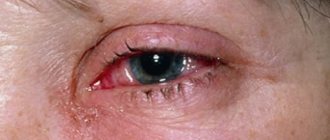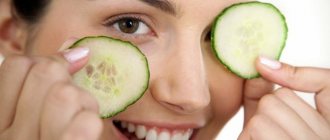Are your eyes more moisturized than they should be?
If your eyes are red and watery, there are many reasons for this. If there is an external irritant, then the reaction of your eyes is quite normal.
Tears soften the eyes by keeping them moist. In an atmosphere of dust and smoke, your eyes protect yourself with tears. However, what if your eyes constantly water even if you change your environment?
Let's look at possible causes and solutions.
Tears as a symptom of pathology
Excessive secretion of tear fluid occurs when the balance between the production of secretion and its removal is disturbed.
From the outside it may seem that the person is crying all the time. Lacrimation can be retentional or hypersecretory. In the first case, the causes of lacrimation from the eyes in elderly and young patients are associated with impaired fluid drainage through physiological channels. The secretion is produced in sufficient quantities, but due to blockage of the duct it is not discharged into the nasal cavity. With hypersecretory lacrimation, the eyes of an adult become watery due to disruption of the lacrimal glands.
When they produce too much secretion, it simply does not have time to be eliminated through physiological channels.
What does tear fluid consist of?
The composition of the secretion of the lacrimal glands is similar to plasma: up to 98% water, the rest is organic compounds, fats, proteins, carbohydrates, enzymes and inorganic substances, including sodium chloride. Just like a drop of blood, a tear can tell a lot about what ails a person. Its composition constantly changes depending on the state of the body, so analysis of tear fluid is informative in the diagnosis of certain diseases.
Features of the composition help tears:
- moisturize the external tissues of the organ of vision and nasopharynx.
- saturate them with nutrients.
- heal corneal injuries.
- protect your eyes from germs.
The enzyme lysozyme, a natural antibiotic with bactericidal and antiviral properties, is responsible for the latter function. It destroys the membranes of pathogenic cells and creates an antibacterial barrier on the mucous membranes of the eye.
The protective function of the tear fluid also lies in mechanical cleansing: when foreign particles enter the eye, more secretion is released, and the tear stream washes away the debris.
In addition, some hormones are removed from the body with tear fluid. In stressful situations, when emotions run high, tears bring relief: this is due to a decrease in the concentration of adrenaline and, as a result, emotional release.
Tearing and burning in the eyes: causes of the pathological condition
One of the common causes of increased tear production is blockage of the tear ducts. It occurs as a result of injury, infection, age-related narrowing of the lumen, or surgery. In some cases, watery eyes occur because the tear duct is blocked by a cyst or tumor. There are other causes of watery eyes in older people, as well as young patients:
- Eversion of the eyelid (ectropion). This condition is accompanied by the formation of a cavity between the lower eyelid and the conjunctiva, which leads to confusion of the lacrimal opening. Most often, ectropion occurs due to the growth of tumors, surgery, or poor visual hygiene. In the absence of therapy, eyelid inversion can become complicated to blepharitis or conjunctivitis.
- Iridocyclitis. Inflammation of the ciliary body and iris is often accompanied by severe pain, photophobia, constriction of the pupil, blepharospasms, and profuse lacrimation.
- Keratitis. Constantly watery eyes are one of the signs of corneal inflammation. The inflammatory process can rapidly progress and spread deep into the eyeball. Therefore, keratitis requires timely treatment by an ophthalmologist.
- Conjunctivitis. In addition to excessive production of secretion from the lacrimal glands, seasonal allergic conjunctivitis is characterized by burning in the eyes, photophobia, hyperemia and swelling of the eyelids. If we are talking about an infectious disease, the appearance of purulent discharge from the eyes is added to these symptoms.
Sometimes lacrimation occurs from one eye in an adult due to inflammation of the facial nerve or paralysis of the facial muscles. In this case, the lower eyelid moves, so the eye does not close completely. To prevent the conjunctiva from drying out, the lacrimal glands increase secretion production.
Fatigue
Why is my right eye watering? The most common cause is ordinary overstrain of the visual organ. Lack of sleep can cause problems. A common factor is prolonged exposure to a computer monitor, when the membrane of the eye is not sufficiently moistened with tear fluid.
If your right eye is watering due to fatigue, it is important to give your visual organs a good rest. Go for a walk, take a relaxing bath, exercise, wash your face and sleep. People who are forced to sit at a computer for hours every day should take short breaks between work and avoid eating in front of the monitor. By neglecting these recommendations, you can develop chronic fatigue of the visual organs, which will cause regular lacrimation and visual impairment.
Tears when wearing lenses
Almost every person who uses contact optics has at least once encountered the phenomenon of tearing. In this case, the abundance of tear secretion may be due to several reasons:
- incorrectly selected lenses;
- violation of the lens wearing regime;
- using lenses longer than prescribed;
- violation of hygiene rules;
- long exposure to lenses in the wind and sun;
- foreign body entering the eye;
- individual intolerance to lenses.
If there is pain in the eyes and watery eyes, a good ophthalmologist can find out the reasons for such phenomena. You should not try to get rid of discomfort with folk remedies at home. Such a decision could have negative consequences.
Often, patients need the selection of the correct contact optics, and only a doctor can do this. An ophthalmologist will also help you choose products for disinfecting and cleaning lenses and teach you how to properly care for them.
Nervous tension
When the right eye is watery, nervous strain may play a role. Neuropsychological disruptions in the body often lead to abundant secretions of local glands. This is often observed during periods of irritability and emotional outbursts. To eliminate trouble, you should avoid various kinds of stressful situations.
Pain in the eyes, watery eyes due to fatigue and dry eyes
Rapid eye fatigue or asthenopia occurs in people who have to read a lot or work at the computer for a long time. When a person focuses his attention on the page of a book or a monitor, the blinking frequency is reduced by 3-5 times. Because of this, there is a feeling of a veil before the eyes, a distortion of the size and shape of objects, a burning sensation, stinging, and lacrimation.
Rapid fatigue of the visual organs requires adequate treatment. As a rule, it is complex and includes restoration of the rest and work regime, vitamin therapy, special visual gymnastics, and selection of corrective optics.
One of the reasons for watery eyes outdoors and indoors may be xerophthalmia or dry eye syndrome. The pathology occurs due to disruption of the stability of the tear film caused by rapid evaporation of tears or hypofunction of the lacrimal glands.
Tearfulness is an early sign of dry eye syndrome, as the visual organs try to somehow compensate for the lack of moisture. But active tear production does not help, since the watery part of the secretion predominates over the mucin and fatty components. Therefore, an abundance of tears does not protect against dry eyes and discomfort.
My eyes are watering
Watery eyes or lacrimation
- a condition when tears accumulate in the conjunctival cavity and flow over the edge of the eyelid.
As a result, eyelid skin irritation, redness, and maceration occur. Constantly flowing tears cause discomfort and irritation. Why do my eyes water and what should I do?
The eyes water only for three reasons: A.
The lacrimal glands produce an excess amount of tear fluid
.
B. Violation of the lacrimal ducts
.
C. Violation of the composition of tears
.
Tear is necessary for constant hydration of the cornea. With a lack of tears, the cornea dries out, becomes cloudy and the person loses vision. This disease is called corneal xerosis. Therefore, to maintain good vision, tear secretion is necessary. Interestingly, approximately 250 ml of tear fluid is produced per day
in each eye.
The same amount of tears is removed from the eye along the lacrimal ducts, which include the lacrimal canaliculus, lacrimal sac and nasolacrimal duct. Each human eye has a lacrimal gland, which is located in the upper outer part of the eye and 18-20 small additional lacrimal glands in the transitional conjunctival fold of the upper eyelid, at the top of the eyelid on the inside. Under normal conditions, only the accessory lacrimal glands constantly function and secrete tears. This tear is completely enough for a person to moisturize the cornea. The main lacrimal gland is activated when the cornea dries out, is irritated by a foreign object, or is subject to psychological (neurological) irritation. My eyes are watering, what could be the reasons? A. Causes causing hypersecretion of the lacrimal glands:
1. “Dry eye syndrome” 2. Dry air 3. Foreign body in the cornea or conjunctiva 4. Chemical irritation of the cornea 5. Inflammatory process in the conjunctiva (conjunctivitis) 6. Inflammatory process of the eyelids (blepharitis) 7. Irritation of the nerves innervating the lacrimal glands, a neurological cause of lacrimation 8. Violation of the psychosomatic state
B. Causes causing disruption of the outflow of tears:
1. Atony (flabbiness) of the lower eyelid 2. Blockage of the lacrimal ducts 3. Inflammatory process in the lacrimal ducts 4. Narrowing of the lacrimal ducts 5 Inversion or eversion of lacrimal openings.
6. Compression of the lacrimal canaliculi by swelling of the eyelids C. Reasons leading to disruption of the composition of tears:
1. Meibomitis - inflammation of the meibomian glands
A. Reasons causing hypersecretion of the lacrimal glands:
1
.
"Dry eye syndrome." Paradoxically, “dry eye syndrome” is one of the two most common causes of lacrimation.
It would seem that a “dry eye” requires hydration and cannot be the cause of excess tears. But it is the drying of the cornea that triggers hypersecretion of the lacrimal gland, which produces a larger volume of tears than the lacrimal ducts can drain. Treatment
: Drops of artificial tears, restoring the tear film and, most importantly, its normal composition, will help get rid of lacrimation in this case.
Massage of the meibomian glands is also recommended to restore their normal functioning. Dysfunction of the meibomian glands leads to disruption of the composition of tears and, as a consequence, to “dry eye syndrome.” It is also necessary to humidify the air in the room, especially in winter. The relative power of air for the normal functioning of the lacrimal organs must be more than 50%. 2 . Dry indoor or outdoor air
causes tears to dry out and the cornea to become dry.
This effect is especially pronounced in countries with hot climatic conditions accompanied by persistent winds. The mechanism of additional tear production is triggered, which is produced in excess, and lacrimation occurs. It should be noted that frosty air is much drier in its physical characteristics than warm air. Therefore, outside in the cold, accompanied by the wind, the tears also quickly dry out and, as a result, an additional increased secretion of tears from the lacrimal gland occurs, which makes the eyes become very watery. Treatment
: maintain relative humidity in the room more than 50%, avoid prolonged stay outside in conditions of too dry, warm or frosty air accompanied by strong winds.
3 .
A foreign body in the cornea or conjunctival cavity , most often an eyelash, leads to disruption of the corneal epithelium, causing “corneal” syndrome, which is always accompanied by redness and severe watering of the eyes.
Treatment
: it is necessary to remove the foreign body and use means that improve the regeneration of the cornea for its speedy recovery: eye drops or gel “Korneregel”, eye ointment “Solcoseryl”, eye drops “Citral” 2-3 times a day.
Once the cornea is restored, the lacrimation will stop. Along with drugs that improve regeneration, it is recommended to use eye drops to prevent secondary infections, such as: Tobrex, Albucid 20%, Levomycetin - 1 drop 3 times a day. 4 .
Chemical irritation of the cornea by substances in the air leads to a reflex increase in lacrimation for increased protection of the cornea, to prevent the negative effects of chemicals on the eye lens, which are washed away by the copious secretion of tears.
We know that our eyes water when we peel onions. This is the most typical example of lacrimation from chemical exposure to the eyes. The same thing happens in a room where there is an excess of ammonia, tobacco smoke, and other active chemicals. Treatment
: It is necessary to rinse the eyes with warm water and leave the room.
For prevention, it is necessary to use safety glasses. 5. Conjunctivitis
, or inflammation of the mucous membrane of the eye, also causes the eyes to water.
In addition to the fact that tears flow, the eyes become red. With bacterial conjunctivitis, pus discharge and swelling of the eyelids occur. Treatment
: it is necessary to determine the cause of conjunctivitis and eliminate it using drugs that suppress the proliferation of viruses or bacteria.
These can be: “tobrex”, “tobradex”, “maxitrol”, “interferon”, “albucid 20%”, “chloramphenicol” - 1 drop 4-6 times a day. 6 .
Blepharitis , or inflammation of the edges of the eyelids, leads to chronic lacrimation, as does the disease itself, which most often has a chronic course.
Lacrimation in blepharitis is associated with swelling of the eyelids and difficulty in the outflow of tears through the lacrimal canaliculi. Treatment
: Treatment of the underlying condition of blepharitis will help get rid of watery eyes in this case.
7 . Irritation of the nerves innervating the lacrimal glands
, a neurological cause of lacrimation.
The innervation of the lacrimal gland is very complex. Four nerves provide its sensitive and secretory functions. This is the “Lacrimal nerve” - the first branch of the trigeminal nerve, a branch of the facial nerve, as well as nerve fibers of the parasympathetic and sympathetic nervous systems. Irritation of these nerve fibers can cause hypersecretion of the lacrimal gland. Irritating factors include tumors, inflammatory diseases on the face, and injuries. Treatment
: neurologists can tell you what to do in this case to stop lacrimation.
8. Violation of a person’s psychosomatic state
is a common cause when the eyes water in excess and tears flow like a river.
Anger, fear, sadness or grief irritate the sympathetic nervous system, releasing the so-called “stress response hormones” - adrenaline, norepinephrine - into the blood. As is known, the lacrimal gland is innervated by the sympathetic nervous system and therefore, when it is irritated, increased tear production occurs. The stronger the stress response, the greater the irritation of the sympathetic nervous system and the more tears flow. Treatment
: drugs that stabilize the nervous system and reduce stress.
“Novopassit”, “Valerian extract” are very suitable. Causes causing disruption of tear outflow:
1.
The second most common cause of lacrimation is atony (decreased tone) of the lower eyelid
. The tear flows from the conjunctival cavity through the lacrimal punctum located on the lower eyelid. Normally, the eyelid has good tone and the point is adjacent to the eyeball.
With age, muscle tone changes, tone decreases, the eyelid becomes flabby and a small gap forms between the eye and the eyelid.
The lacrimal punctum moves away from the eyeball, the tear cannot find its outflow path and overflows the edge of the eyelid. This happens when the eyes water due to age-related disorders in the body - atony of the lower eyelid. Treatment
: treatment in this case can only be surgical.
There are two directions of treatment: expansion of the lacrimal punctum or excision of part of the lower eyelid to increase its tone and return to its original state, when the lacrimal punctum is again adjacent to the eyeball and the tear outflow path is restored. 2. Blockage of the lacrimal ducts
can occur at any stage.
In adults, blockage of the tear ducts most often occurs. The cause of blockage may be discharge from conjunctivitis, blepharitis, mascara and other similar reasons. Disruption of the outflow in the lacrimal sac occurs after inflammatory diseases of the lacrimal ducts, dacryocystitis, canaliculitis. In such cases, the products of inflammation remain in the lacrimal sac and obstruct the outflow of tears. Diagnosis is made by taking x-rays with a contrast agent filling the tear ducts. Treatment
: Violation of the conductivity of the lacrimal canaliculi is carried out by dilating and washing them.
As a rule, such procedures give a lasting positive effect. 3. Inflammatory process in the lacrimal ducts
.
Dacryocystitis is inflammation of the lacrimal gland. Dacryocystitis is characterized by the accumulation of inflammatory products in the lacrimal sac, its swelling, redness and pain in the area of the internal commissure of the eyelids. At the same time, tears, as a rule, “run in a stream.” Canaliculitis is inflammation of the tear ducts. Diagnosis of canaliculitis is difficult, since there are no external signs of inflammation other than lacrimation. Treatment
: Treatment must be carried out in a specialized surgical facility, since for successful treatment of dacryocystitis it is necessary to create a path for the outflow of inflammatory fluid of the lacrimal sac, which is carried out surgically.
4. Narrowing of the lacrimal ducts
, or their stricture, is, as a rule, a consequence of inflammatory processes of the eye - conjunctivitis, inflammation of the eyelids, blepharitis.
Damage to the epithelial wall of the lacrimal ducts due to infection leads to narrowing of the lumen and disruption of the outflow of tears. Treatment
: Bougienage of the lacrimal and nasolacrimal ducts.
If there is no effect, they resort to plastic surgery. 5. Inversion or eversion of the lacrimal openings
is a consequence of injury or very severe inflammation of the eyelids.
As a result of the scarring process, the lacrimal punctum is displaced, and tears cannot flow down the lacrimal ducts. The eyes are very watery. Treatment
: Cosmetological treatment of volvulus or eversion of the lacrimal punctum can only be surgical.
6. Compression of the tear ducts by swelling of the eyelids
is the most common cause of
watery eyes in the morning
.
If your eyes are very watery in the morning, pay attention to whether you have swelling of your eyelids and face. Low mobility of a person at night and a violation, especially with age, of the water-salt balance leads to stasis (slowing down of the flow) of fluid in the body, which accumulates in tissues rich in fiber, which include the eyelids. Excessive accumulation of interstitial fluid compresses the tear ducts and can lead to severe watery eyes in the morning, which goes away as the person stays awake and moves. Nocturnal lymphostasis, which occurs for a variety of reasons from cardiac dysfunction, renal failure to varicose veins, can be the reason why tears flow in the morning. Treatment:
if, in addition to tears in the morning, you notice swelling of the eyelids, then it is necessary to carry out active physical exercises, at least for a few minutes. Muscle work will improve lymphatic drainage, swelling of the eyelids will subside and lacrimation will stop. In order to more accurately understand the malfunctions of the body, it is necessary to consult a therapist, who, based on examinations, recommends consultation with a specialist.
C. Reasons leading to disruption of the composition of tears:
1. Meibomitis (meibomitis) - inflammation of the meibomian glands
Meibomite is the third most common cause of watery eyes.
The meibomian glands are found in the intermarginal margin of the eyelids (the edges of the eyelids that touch when the eyes close). The meibomian glands produce a special viscous secretion that is found in the superficial layer of the tear. The tear consists of 99% water, so it dries quickly. The secretion of the meibomian glands prevents this process. When the meibomian glands become inflamed, the composition of the secretion changes or is completely absent when the glands are clogged with inflammatory products. In this case, the biochemical composition of the tear changes and the tear dries very quickly on the surface of the cornea, irritation occurs and, as a result, increased tear production, the eyes begin to water during this process. Treatment
: massage of the edges of the eyelids is necessary (5-7 days) with the use of anti-inflammatory ointments: “tetracycline”, “gentamicin”, “hydrocortisone”. Treatment always has a positive result.
10.08.2021
Author, Ph.D. Oleg Getto
Watery eyes: causes and treatment with modern methods
One simple way to symptomatically treat tearing is eye drops. They have different compositions, so they can be used for dry eye syndrome, conjunctivitis and other diseases. The choice of solution is made only by a doctor after a thorough diagnosis and clarification of the causes of the pathological condition.
If we are talking about excessive production of tears caused by dryness or fatigue of the visual organs, computer syndrome, hypofunction of the lacrimal glands, you can use Delfanto® as an alternative to drops.
This innovative product appeared in Russia in 2021. It has a completely natural composition. The basis of Delfanto® capsules is a standardized MaquiBright® extract, which contains 35% antioxidants. The active components of the extract help eliminate the effects of oxidative stress and restore cells of the lacrimal glands. They also improve the quality of tear fluid and normalize its production.
The drug Delfanto® has undergone clinical testing. It can be used simultaneously with eye drops. But already a few weeks after the start of therapy, you can abandon ophthalmic solutions as unnecessary.
Treatment
Short-term increased lacrimation of physiological origin goes away on its own after the irritating factor ceases.
Important! Until the symptom completely stops, it is necessary to limit visual stress, avoid contact lenses for a while, and maintain optimal humidity in the room.
If you have visual fatigue, your doctor may prescribe eye drops for fatigue and tension. They protect the cornea, eliminate discomfort and burning sensation, and moisturize. It is strictly forbidden to use eye drops without a prescription from a specialist.
If you have other symptoms of the disease, in addition to complaints of watery eyes, you need to visit an ophthalmologist or family doctor; if the condition quickly worsens, call an ambulance. After examining the patient and making an accurate diagnosis, the doctor prescribes treatment aimed at eliminating the underlying disease.
Conservative therapy
Treatment tactics depend on the causes and form of the disease, and may include:
- Antiseptic drugs. Local treatment of the conjunctival sac is prescribed to prevent infectious and inflammatory complications.
- Antibacterial ointments and gels. Necessary in the case of diagnosing infectious eye diseases. Broad-spectrum antibiotics are usually used.
- Antihistamines and hormonal drugs. Placed in the conjunctival cavity for allergic diseases or taken orally (inside).
- Non-steroidal anti-inflammatory drugs. Stop inflammation, eliminate local symptoms such as pain, swelling, redness.
- Analgesics. Prescribed in the form of drops or tablets to reduce the intensity of pain.
- Reparation stimulants. Accelerate the regeneration of the corneal epithelium in case of mechanical damage, after surgery, erosion.
- Injections of hyaluronic acid into the upper eyelid area. Performed for lagophthalmos to correct the position of the palpebral fissure.
To enhance the results of drug therapy, physiotherapy is prescribed: laser therapy, phonophoresis and electrophoresis, UHF, eyelid massage.
Using inappropriate cosmetics
Often, increased lacrimation results from irritation of the mucous membranes of the visual organ by chemical components of cosmetics. It is not difficult to determine whether this is really the cause of the problem. It is enough to stop using cosmetics for a while. A change in the overall picture for the better will indicate the need to change one or another product.
Anti-lacrimation medications
If your eye becomes watery due to the development of an allergic reaction, doctors advise using the drug Allergodil. Antihistamine drops help eliminate the unpleasant symptom by reducing the level of capillary permeability in the structure of local tissues and suppressing the body's susceptibility to specific irritants. The medication is safe for children over 4 years of age.
Another effective remedy prescribed by ophthalmologists for the development of lacrimation is Tobrex. Eye drops produce a pronounced disinfecting effect on local tissues. It is advisable to use the drug in situations where trouble is caused by the development of conjunctivitis and other bacterial infections.
If there is eye strain or the consequences of foreign bodies getting on the mucous membranes, doctors recommend using Visin drops. The use of the medication relieves swelling and constricts blood vessels. As practice shows, lacrimation stops within the first minutes after instilling the product into the eye.
Table of contents:
Causes of tearing Classification Symptoms and diagnosis Treatment of tearing eyes Prevention
Tearing is a natural process. The fluid secreted by the tear glands moisturizes the surface of the eye and protects the mucous membrane from dust and other particles. Excessive lacrimation occurs during inflammatory processes. It signals the development of ophthalmopathology. Treatment of tearing eyes should be carried out under the supervision of a doctor, since if treated incorrectly, the infection can lead to suppuration and deterioration of vision.









